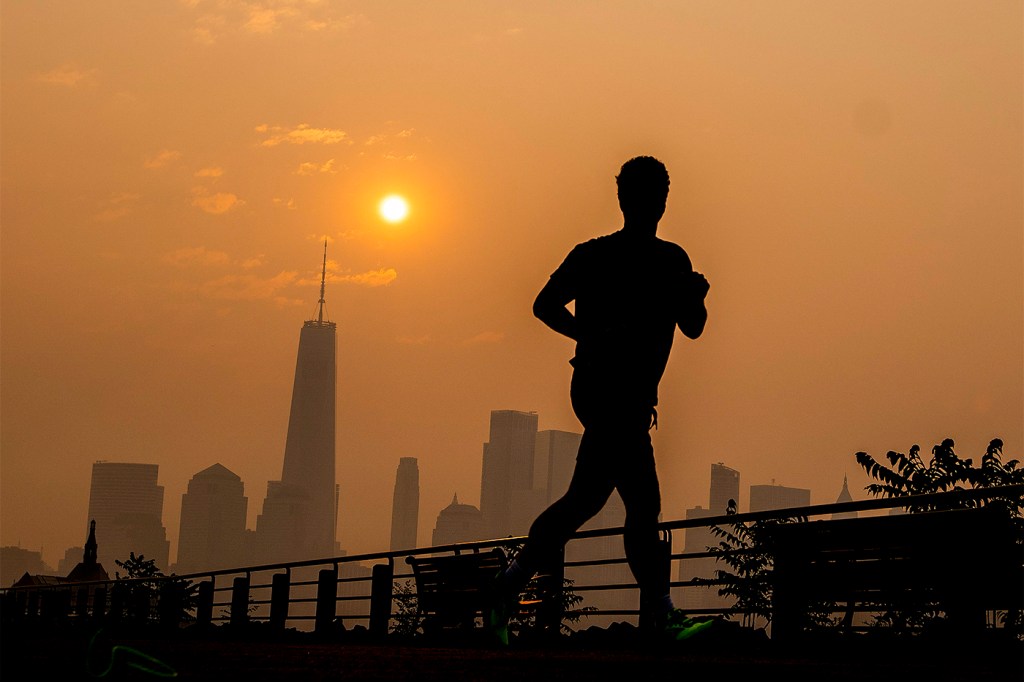How to protect yourself from wildfire smoke

The wildfire haze that is turning air quality in New England hazardous and New York City skies orange is an unusual event for the East Coast of the U.S.—but it may not be for long.
Northeastern University professor Yang Zhang says to expect more of such events in the future, as the risk of wildfires grows.
She joined other Northeastern experts to offer advice on what people can do to protect themselves and their families.
Use the air quality index…
Check the color-coded maps on the Environmental Protection Agency’s Air Quality Index to see when it’s safe to go outdoors, says Zhang, who co-authored a paper published in February showing wildfires will pose an increased risk to air quality in the Eastern U.S. by 2050.
The index divides air quality values from 0 to 500 into six color categories—green, yellow, orange, red, purple and maroon, with values getting more hazardous as numbers get higher.
Green on the map means air quality is satisfactory, while maroon with values of 301 and up indicates a health emergency condition that could affect everyone regardless of age and physical condition.
On Wednesday, New York City’s AQI reached 405 out of 500, the highest ever recorded for the metropolis. The hazardous conditions led to the closing of some schools and the cancellation of Broadway and sporting events.
There is definitely a benefit to N95 masks. They are going to be able to filter out 60 to 80% of particulates.
Trenton Honda, clinical professor in Northeastern’s department of medical sciences and associate dean of the School of Clinical and Rehabilitation Sciences
…to make healthy decisions
Referencing air quality maps can help people make healthy decisions, says Trenton Honda, clinical professor in Northeastern’s department of medical sciences and associate dean of the School of Clinical and Rehabilitation Sciences.
“You can look on your phone and see the AQI is high and decide, ‘I’m not going to go on that run I was planning to do,’” he says.
But air quality conditions may be dangerous for people with health sensitivities or conditions at lower values, even when the AQI is color coded yellow or orange, says Zhang, a professor and distinguished fellow, and associate chair for research, civil and environmental engineering.
Know when to stay indoors
Under those conditions, she says, “Stay indoors as much as possible. Don’t go out unless it’s absolutely necessary. This is particularly true for children, the elderly or whoever has a history of respiratory type of disease or heart and lung disease.”
It only takes up to 24 hours of exposure to hazardous air conditions for hospitalization and mortality rates to increase for people with illnesses including acute and chronic bronchitis and asthma, Zhang says.
“It’s a very, very severe health impact,” she says.
The AQI measures different types of pollutants, including particulate matter from wildfires.
Particulates from wildfires produce “ultrafine particles” that can reach deep into the lungs and upset normal physiology, Honda says.
Effect on the rest of the body
They can cause oxidative stress and inflammation in the lungs, which has a spillover effect on the rest of the body. “They irritate the lining of the lungs” and move directly into the bloodstream.
“When we have these really, really bad air quality events, there are likely excess deaths that are happening,” Honda says. But “nobody writes air pollution on the death certificate. You write ‘asthma.’ You write, ‘heart attack.’”
There’s also evidence that prolonged exposure to wildfire smoke can cause blood vessels to stiffen, says Chiara Bellini, a Northeastern associate professor in bioengineering, who participated in a study of the effects of smoke inhalation on forest firefighters.
“It makes it harder for the heart to pump blood through the system,” she says. “That renders the entire system less efficient.”
Wear a mask when the AQI is high
Staying inside means closing windows and shutting doors, Honda points out.
He also is a fan of wearing a mask when the AQI is high.
Surgical masks are designed to filter out droplets, not particulates, but “there’s not zero benefit,” Honda says.
“There is definitely a benefit to N95 masks. They are going to be able to filter out 60% to 80% of particulates,” Honda says.
Jessica Oakes, an assistant professor in bioengineering, who co-led the smoke inhalation study with Bellini, met plenty of forest firefighters who used bandannas to cover their faces to protect themselves from smoke.
“We really think that’s not the best idea. It doesn’t really do anything to protect them from the smoke,” Oakes says.
“The N95s really fit your face,” she says, adding that the filter material is superior to the filter in a surgical mask when it comes to smoke inhalation.
Filtration in housing is important
“Filtration in housing is really important. If you have air filters, keep those up to date to alleviate the smoke coming into houses or into buildings,” Oakes says.
“Anything that filters” is beneficial, Bellini says. “The closer knit it is the better it is at filtering. Keep them clean.”
Cynthia McCormick Hibbert is a Northeastern Global News reporter. Email her at c.hibbert@northeastern.edu or contact her on Twitter @HibbertCynthia.






